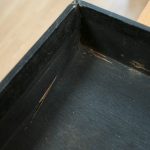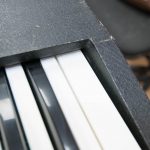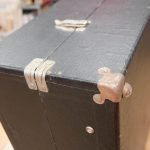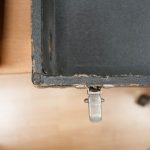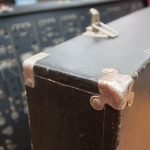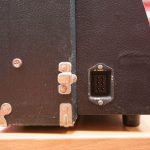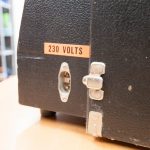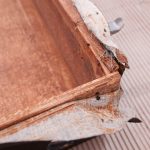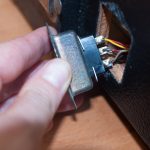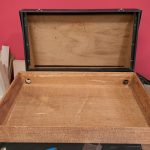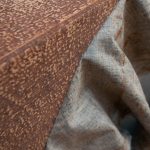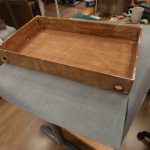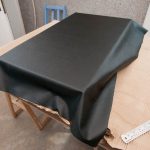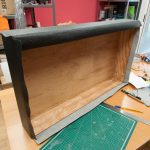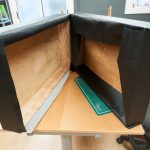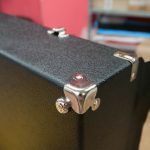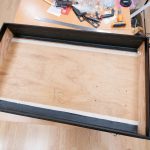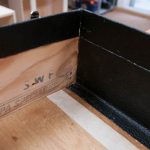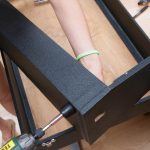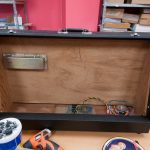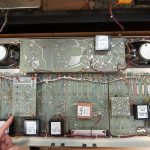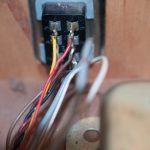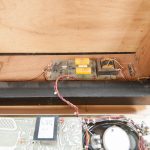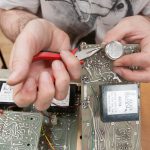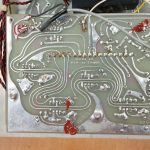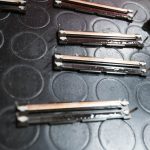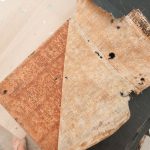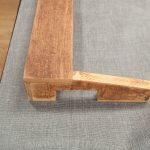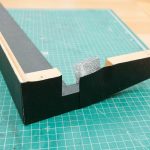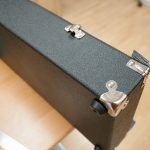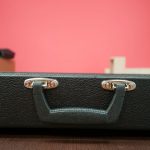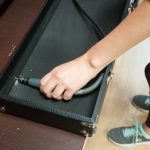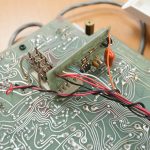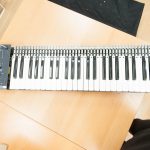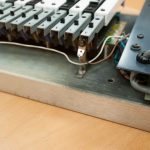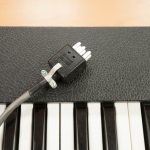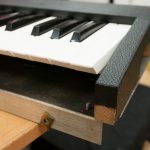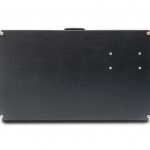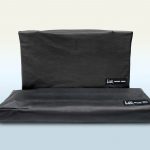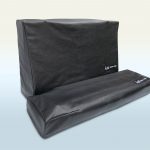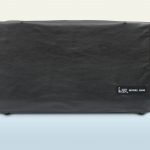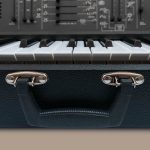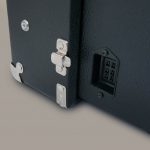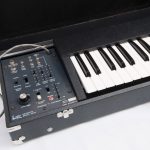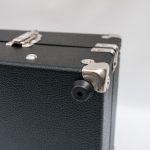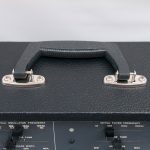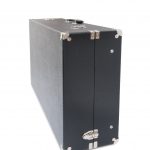At summer of 2021 we have had a very special visit. Previously, some classic ARP 2600s have arrived to Antonus’ workshop for some kind of repair, but in this case what has come to us involves repair and restoration, both at deep level.
A beautiful challenge because the functional and aesthetic status was not good, but really such an instrument deserves all the work, effort and resources. It is very important in cases like this that the owner of the instrument knows the value of his instrument since it takes a considerable amount of resources and a lot of time and patience to achieve the optimal result. All the members of the Antonus staff have participated in this restoration, first the girls Nali and Carla working at the entire part of the cabinet and the boys Toni and Charly the electronic part.
The 2600 has had to be completely disassembled, and completely separate the electronics and panel from the cabinet.
The cabinet had a damaged Tolex, with some bumps or deformities that affected the wood and some rusty hardware. First is to begin the process of removing rusty and damaged hardware, and removing old and damaged Tolex.
The wood has needed a restoration process due to damage and imperfections. Once the wood has been restored, the covering process with new Tolex begins.
The original hardware were badly damaged so in this case we use new parts. Fortunately at Antonus we have stock of new and original parts, hardware and rivets.
Although this is easy to write, it is a very delicate process that takes a lot of time and attention.
Taking advantage of this process, the original power connector is replaced, which is incompatible with the current standard and which previously required to depend on the original cable.
By installing a 3-pin IEC normal cable we can use the common and readily available cables today.
Also time to change the keyboard connector socket, since it is a very delicate point that, if it is not in perfect condition, can cause many problems in the tuning and stability of the instrument
The PCB’s were completely removed from the panel to allow proper cleaning and to proceed with the installation of dust filters for the sliders.
In the electronic part, the instrument had defects in many parts, most of the sections were not working right, with different instabilities and noises. Even parts like the VCF were completely dead.
The power supply has been repaired and improved with the replacement of the old transformer that had excessive noise levels, with a new one with a toroidal design that allows us to stop the issue. It is assembled on a new separated PCB that incorporates, in addition to the main fuse, two additional ones for the transformer’s secondary ones, adding protection to both parts of it. A voltage selector is added on the same PCB so that it is possible and easy to change between 100v / 120 to 220 / 240v.
At the reverb tank, it was necessary to change the RCA connectors, since they showed signs of rust and great deterioration.
At synthesizer boards, it has been necessary to work in large blocks, first at replacement of all polarized capacitors that, with almost 50 years, have far exceeded their life span.
The next basic repair is related to slide potentiometers. In these cases, it is necessary to evaluate whether it is convenient to clean or replace with new parts. We verified that the sliders inside, despite the dirt, had the key elements in good condition and that with good deep cleaning and new lubrication they could be as good as new. This option means a considerable money saving because getting new sliders for the 2600 is expensive today.
The same goes for jack connectors. In this case, the patch connectors are also expensive due to the fact that they are Tiny Jax connectors (custom diameter and lead layout, they are different from the usual Mini-jack due to a difference in diameter) with which everything that can be restored supposes good money savings for the customer. In this case, they were able to restore without problem, doing a dedicated and patient cleaning.
The slide switches presented more problems with contact and smoothness, so in the end it was decided to change for new parts.
With these base repairs we can continue to repair the instrument. Knowing that these elements were already fixed, it was possible to diagnose some faults in some integrated circuits. As we at Antonus use original parts to build our 2600 equipment, we have plenty of stock for these repairs. We install high quality turned socket for the new chips.
More complicated is the moment when the diagnosis shows that some ARP epoxy modules are faulty.
In certain units these modules came without epoxy coverage, but bad luck, in this equipment all modules are sealed except for ADSR 4020 and NOISE 4022 which do not have epoxy.
In the 4020 and 4022 we can proceed with the proper recap.
The 4015 Sample And Hold module does not present any problem, it works perfectly and there is no polarized capacitor inside it, so it is not necessary to replace it due to failure or prevention.
The rest of the sub modules had different types of failures. In that case, was necessary to replace it with new modules manufactured by Antonus using the original circuits and components with dedicated selection processes and with thermal coupling in the sensitive parts.
High-quality turned sockets are used in integrated circuits, which makes it an easy and comfortable task if these components need to be changed in the future.
With the installation of the new sub-modules, the beast was ready to sound properly. The calibrations can already be done within the recommended ranges and the behavior and sound is as it should be.
With the keyboard there is also a complex task, since on the one hand we have that the cabinet has many problems. In addition to old and damaged Tolex, rusty hardware, we have major blows and in this case the top cover is missing, at some point one of the previous owners lost it somewhere.
Completely disassembling the keyboard and removing the tolex shows that the wood is in a worse state than expected. If the wood is restored, it will take excessive time and resources and it will still not be perfect. If we make a new lid there will be a lot of difference between the perfection of the lid and all the deformities of the base, so in this case it is worth re-manufacturing a new wooden base.
Once we have all the parts new made, we have to put the Tolex and the hardware and we have a new ARP 3620 keyboard cabinet ready.
Now it’s time to repair the electronics and mechanics of the keyboard. General cleaning and then detailed cleaning of the potentiometers and switches. In the case of the pushbutton, it was destroyed on the inside, which means that must be replaced by a new one.
The connection cable was also damaged, so it is time to replace it with a new one.
The keyboard part needed to be disassembled to be able to access a good internal cleaning.
A couple of contact springs were broken and the base had to be repaired. The bus bars themselves and the springs all had to be cleaned in detail.
The keyboard bed had to be leveled again for each key as it exhibited notable deformities. The keys were cleaned one by one and lubricated and damped to avoid unpleasant noises and bad touch feeling.
Finally this beautiful Arp 2600 and its ARP 3620 keyboard have a new life, rejuvenated but preserving all the essence, personality and magic of the time. It is a pleasure to play this instrument and enjoy it with all the trust and stability as if it were out of the factory. Every time that work with an instrument like this I fall in love more with this personality and behaviour, I have every day more clear that there are things about the original 2600 that should not be “improved” because they are part of the personality and shape. Each restoration is a load of motivation and inspiration for new work. For example, with this work we have been inspired to make new covers to protect from dust to match and match the look of the instrument, both for the 2600 and the 3620. Once again, Nalini’s eye and hand have made this possible and the idea is offer it also for any user of classic Arp 2600 and KARP FS. I hope you like the result and we remember that the Antonus workshop is still available for restoration and maintenance of these wonderful instruments.


